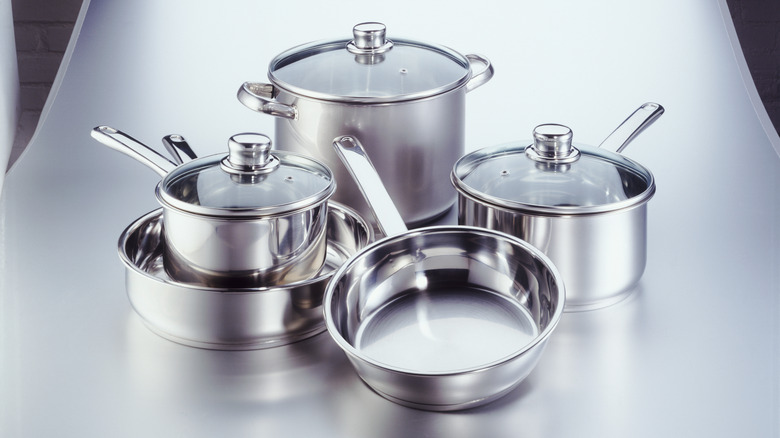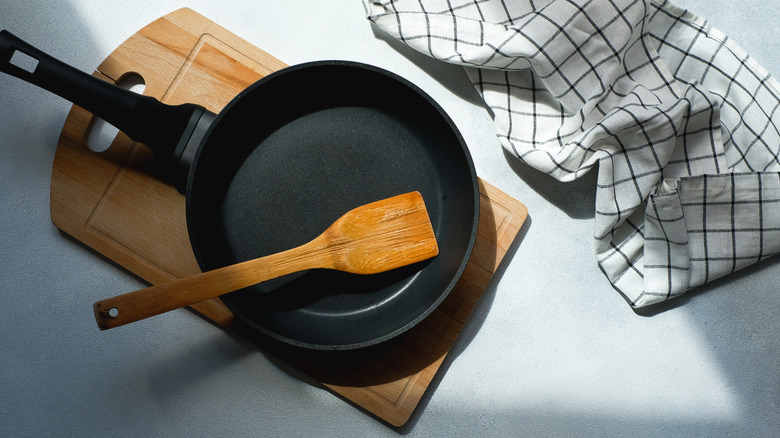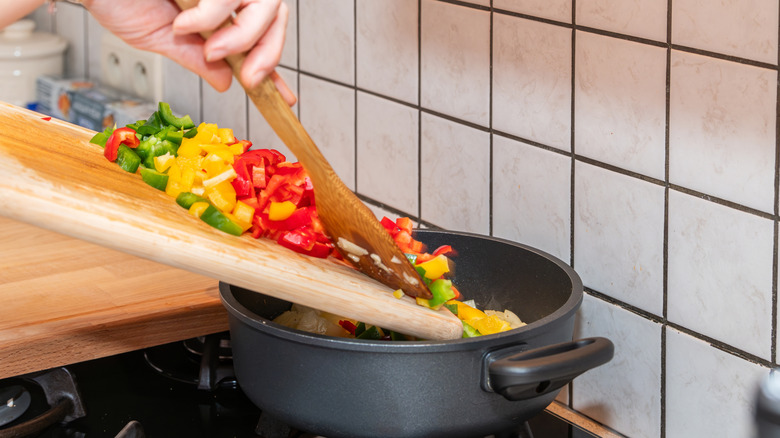How Many Different Pots And Pans Do You Actually Need?
After you've spun the block a few times, you grow weary of the hodgepodge mess in and about your kitchen cabinets — which is most often referred to as cookware. Here's the piercing question that every cook overrun with kitchenware ponders at some point. Do I really need all of them? I have good news ... there's light at the end of the tunnel — you do not need 17 skillets. Downsizing is very much possible, and dare I say, even encouraged.
The key to this cheat code is versatility and high quality; you need pieces capable of handling every cooking task under the sun. The focus isn't just on stocking the kitchen, it's on stocking the kitchen efficiently. An organized kitchen will most certainly include a saucepan for sauces and soups, a skillet for frying and sautéing, a stockpot for large batches, and, of course, a baking dish for those delicious oven recipes. There's no doubt that specialty pans like woks can be nice additions, but they're not essential for many home cooks. (I know some people who love their wok, so that tip might ruffle some feathers, but oh well ... )
Take a more strategic approach and choose multipurpose items that can do double the duties. Take a Dutch oven, for example. It can handle soups, stews, and even bread baking. You get the idea. By focusing on functionality rather than collecting every single pan you come across, you'll save money and storage space and still be ready to cook just about anything. Now, all that's left to do is to determine which pieces are must-haves in your kitchen.
Essential pots and pans for everyday cooking
The old adage "less is more" doesn't work everywhere, but it for sure does here. We recommend starting with a stainless steel saucepan. It's the perfect companion in the kitchen, great for simmering sauces, boiling pasta, or reheating leftovers. A stainless steel pan is super durable. Trust me, there's nothing like doing some steady cooking in your saucepan, only for it to be ruined before half of the year is up. You don't have to worry about that with this bad boy at your side.
Next, a good nonstick skillet is a must for quick meals like scrambled eggs or stir-fry. It's easy to clean and ideal for low-fat cooking. For heartier tasks, invest in a cast iron skillet. Its ability to retain heat makes it perfect for searing, roasting, and even baking cornbread.
For larger meals, a stockpot is the way to go. Use it for soups, stews, and boiling water for pasta or vegetables. If you love baking, a casserole dish or roasting pan is a smart purchase, handling everything from lasagna to roasted chicken. These essentials will cover most recipes and keep your kitchen functional without overwhelming your cabinets.
Why quality always beats quantity
It's tempting to buy cookware sets with every pot and pan imaginable, but quality always trumps quantity. Cheap cookware often heats unevenly, leading to burnt spots or undercooked food. High-quality pieces, like stainless steel or cast iron, are durable and offer superior performance. If you go cheap and end up constantly having to replace them, you're just burning through money unneccesarily.
Consider how often you'll use each item. A high-end skillet you use daily is a better investment than a specialized pan that gathers dust. Versatile cookware saves you time and hassle, as you can use the same pan for multiple tasks. Plus, fewer, better items mean less clutter and easier cleanup.
Focus on pieces that feel sturdy, have comfortable handles, and don't get warped easily. With just a few high-quality pots and pans, you can confidently tackle everything from a quick breakfast to a multi-course dinner. And when your cookware lasts for years, you'll thank yourself for skipping the flashy extras.


